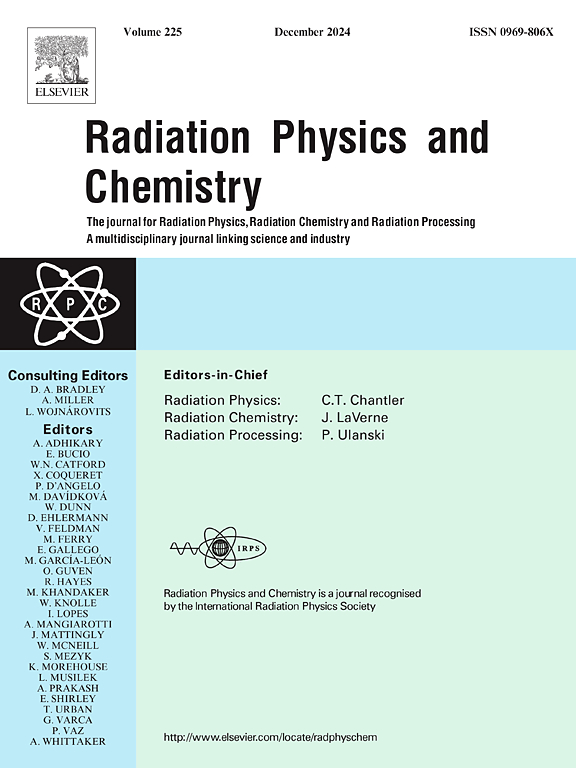Enhanced radiation shielding properties of bismuth tellurite glasses: A study on mass attenuation, equivalent atomic number and build-up factors
IF 2.8
3区 物理与天体物理
Q3 CHEMISTRY, PHYSICAL
引用次数: 0
Abstract
This research examines the gamma-ray shielding properties of bismuth tellurite glasses with the composition (85-x)TeO2–15B2O3-xBi2O3, where x ranges from 0 to 65 mol% for photon energies between 0.015 MeV and 15 MeV. The study found that the addition of Bi2O3 significantly improved the density & shielding efficiency of prepared glass samples, which increased from 5.37 g/cm3 to 7.26 g/cm3. The mass attenuation coefficient (MAC) declines with increasing photon energy but peaks at 90.52 keV due to bismuth's K-edge absorption highlighting strong photon interaction. The effective atomic number (Zeff) and equivalent atomic number (Zeq) are highest at lower photon energies, emphasizing the dominance of the photoelectric effect. Electron density (Ne) follows a similar trend, reinforcing the improved shielding performance of high Bi2O3 glasses.
The exposure build-up factors (EBF) and energy absorption build-up factors (EABF) were calculated using the WinXCom software and the Geometric Progression (G-P) fitting method. The result indicated that these bismuth tellurite glasses particularly the G5 glass sample demonstrate superior shielding performance compared to traditional lead glasses, especially for high-energy radiation. This suggests that these glasses could serve as effective, environmentally safer alternatives for radiation protection.
碲酸铋玻璃的增强辐射屏蔽性能:质量衰减、等效原子序数和累积因子的研究
本研究考察了组成为(85-x) TeO2-15B2O3-xBi2O3的碲酸铋玻璃的伽马射线屏蔽性能,其中光子能量在0.015 MeV和15 MeV之间,x的范围为0到65 mol%。研究发现,Bi2O3的加入显著提高了密度&;制备的玻璃样品的屏蔽效率由5.37 g/cm3提高到7.26 g/cm3。质量衰减系数(MAC)随着光子能量的增加而下降,但由于铋的k边吸收突出了强光子相互作用,MAC在90.52 keV处达到峰值。有效原子序数(Zeff)和等效原子序数(Zeq)在光子能量较低时最高,强调了光电效应的主导地位。电子密度(Ne)也有类似的趋势,增强了高Bi2O3玻璃的屏蔽性能。采用WinXCom软件和几何级数(G-P)拟合方法计算暴露累积因子(EBF)和能量吸收累积因子(EABF)。结果表明,与传统的铅玻璃相比,这些碲酸铋玻璃特别是G5玻璃样品具有更好的屏蔽性能,特别是对高能辐射的屏蔽性能。这表明这些眼镜可以作为有效的、更环保的辐射防护替代品。
本文章由计算机程序翻译,如有差异,请以英文原文为准。
求助全文
约1分钟内获得全文
求助全文
来源期刊

Radiation Physics and Chemistry
化学-核科学技术
CiteScore
5.60
自引率
17.20%
发文量
574
审稿时长
12 weeks
期刊介绍:
Radiation Physics and Chemistry is a multidisciplinary journal that provides a medium for publication of substantial and original papers, reviews, and short communications which focus on research and developments involving ionizing radiation in radiation physics, radiation chemistry and radiation processing.
The journal aims to publish papers with significance to an international audience, containing substantial novelty and scientific impact. The Editors reserve the rights to reject, with or without external review, papers that do not meet these criteria. This could include papers that are very similar to previous publications, only with changed target substrates, employed materials, analyzed sites and experimental methods, report results without presenting new insights and/or hypothesis testing, or do not focus on the radiation effects.
 求助内容:
求助内容: 应助结果提醒方式:
应助结果提醒方式:


